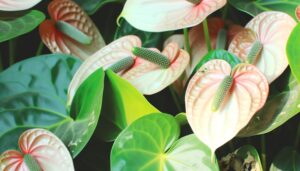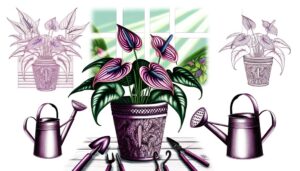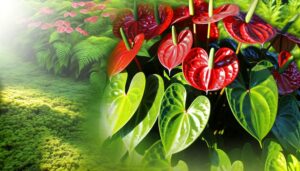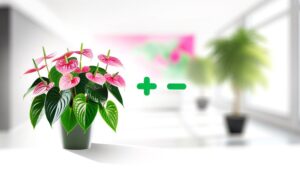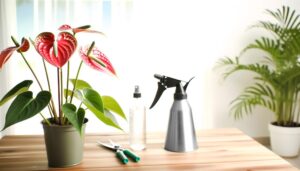Unique Indoor Plant: What Makes Anthurium Cavalli Purple Special?
The Anthurium Cavalli Purple is a distinctive indoor plant, known for its remarkable purple spathes, a result of high anthocyanin concentration. Its dark green foliage, abundant in chlorophyll, enhances photosynthesis efficiency.
The plant's glossy leaves not only improve its aesthetic appeal but also optimize its functional capabilities. It requires minimal care due to its efficient water retention and low light adaptability.
Moreover, it purifies indoor air effectively via its stomatal conductance. Anthurium Cavalli Purple also boasts long-lasting blooms and versatility in décor settings, thriving in diverse environments.
Enhance your knowledge of this extraordinary plant by exploring further details.
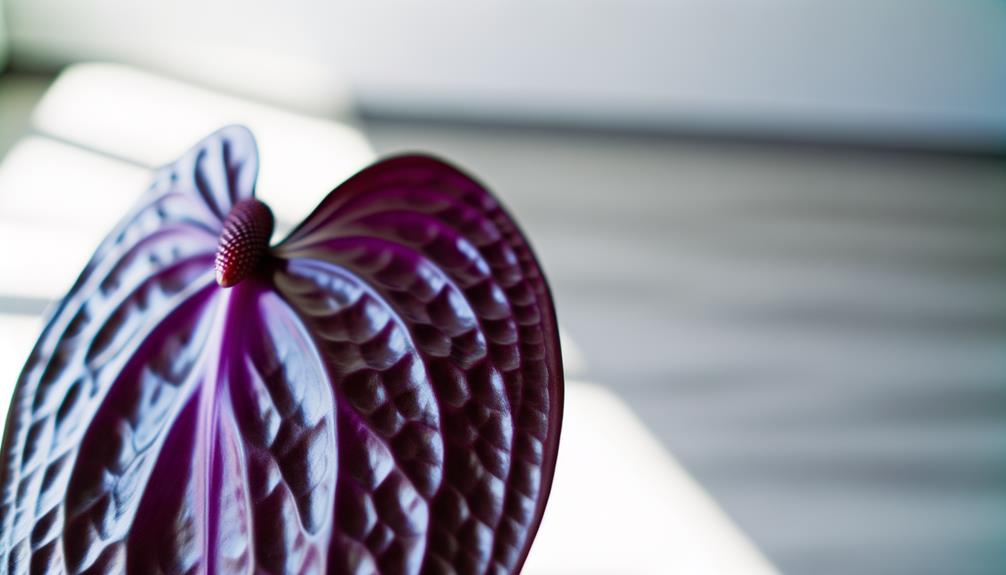
Key Takeaways
- Striking purple spathes with vibrant color due to high anthocyanin content.
- Low-maintenance care with efficient water retention and low watering needs.
- Thrives in low light conditions and has strong pest resistance.
- Glossy dark green foliage with high chlorophyll content for efficient photosynthesis.
- Long-lasting blooms and versatile decor options, enhancing air quality.
Striking Purple Spathes
The Anthurium Cavalli Purple is distinguished by its striking purple spathes, which exhibit a vibrant and uniform coloration due to high anthocyanin pigment concentrations. These pigments, known for their role in photoprotection, are responsible for the plant's intense hue, which is both aesthetically pleasing and functionally significant.
Research indicates that anthocyanins absorb specific wavelengths of light, protecting cellular structures from photodamage while enhancing pollinator attraction. The spathes themselves, a modified leaf structure, serve to envelop the spadix, the true flowering component of the plant. This anatomical feature not only aids in reproduction but also contributes to the plant's ornamental value, making it a sought-after specimen in both botanical collections and interior landscaping.
Dark Green Foliage
Complementing the vivid purple spathes, the Anthurium Cavalli Purple boasts robust, dark green foliage characterized by its high chlorophyll content and broad, glossy leaves that enhance the plant's overall photosynthetic efficiency. The dense chlorophyll not only provides a deep green hue but also optimizes light absorption, essential for sustaining the plant's vibrant appearance.
| Leaf Trait | Description | Benefit |
|---|---|---|
| High Chlorophyll | Dense concentration of chlorophyll | Maximizes light absorption |
| Broad Leaves | Expanded surface area | Improved photosynthesis |
| Glossy Finish | Reflective surface texture | Reduces water loss |
These traits collectively support the Anthurium Cavalli Purple's essential functions, ensuring robust growth and maintaining its aesthetic appeal in indoor environments. The foliage's ability to efficiently convert light energy underscores the plant's unique adaptation for thriving indoors.
Low-Maintenance Care
Anthurium Cavalli Purple is distinguished by its minimal watering requirements, thriving with infrequent hydration due to its efficient water retention mechanisms.
This species demonstrates low light tolerance, adapting well to indirect sunlight while maintaining robust growth.
Additionally, it exhibits significant resistance to common pests, reducing the need for intensive care interventions.
Minimal Watering Requirements
Promoting peak health for Anthurium Cavalli Purple necessitates precise regulation of watering, as excessive water can lead to root rot and other detrimental conditions. This plant demonstrates a remarkable resilience to sporadic watering due to its epiphytic nature, which allows it to thrive with minimal upkeep.
Best watering practices involve allowing the top layer of soil to dry out between waterings. Key considerations include:
- Soil Moisture: Use a well-draining potting mix to prevent waterlogging.
- Water Quality: Use room-temperature, filtered water to avoid chlorosis and mineral buildup.
- Environmental Humidity: Maintain moderate humidity levels, ideally between 60% and 80%, to replicate the plant's native tropical conditions.
These guidelines help Anthurium Cavalli Purple maintain its vibrant appearance and robust health.
Low Light Tolerance
Exhibiting a remarkable adaptability to suboptimal lighting conditions, the Anthurium Cavalli Purple thrives even in low-light environments, making it an ideal choice for interior spaces with limited natural light.
This species exhibits efficient photosynthetic pathways that optimize light absorption, enabling sustained growth and strength in diminished luminescence. Research indicates that Anthurium Cavalli Purple can effectively utilize low-intensity diffused light, reducing the need for supplemental artificial lighting.
This adaptability is attributed to its chlorophyll concentration and leaf morphology, which maximize light capture. Consequently, the Anthurium Cavalli Purple demands minimal intervention, aligning with low-maintenance care protocols.
Its capacity to flourish under these conditions underscores its suitability for urban dwellings and office settings, contributing to its popularity among indoor plant enthusiasts.
Pest Resistance
The strong pest resistance of Anthurium Cavalli Purple greatly reduces the need for frequent interventions, thereby aligning with its reputation for low-maintenance care. This plant exhibits innate defenses against common pests through its thick, waxy leaves and strong cellular structure, minimizing infestation risks. Research indicates that these attributes contribute to:
- Reduced vulnerability to aphids and spider mites, which are common threats to indoor plants.
- Minimal fungal infections, owing to its efficient moisture regulation and transpiration.
- Enhanced resilience against environmental stressors, such as low humidity and temperature fluctuations.
These pest-resistant characteristics make the Anthurium Cavalli Purple an ideal choice for both novice and experienced plant enthusiasts, ensuring longevity and reduced maintenance efforts. This plant serves as a demonstration of the advancements in horticultural breeding and selection.
Ideal Indoor Conditions
To optimize the growth and health of Anthurium Cavalli Purple, it is important to focus on specific indoor conditions such as light and placement, precise watering guidelines, and adequate humidity levels.
Research indicates that these factors greatly influence the plant's physiological functions and overall vitality. Proper management of these conditions can lead to enhanced foliage and prolonged blooming periods.
Light and Placement
Position Anthurium Cavalli Purple in a location where it can receive bright, indirect light to mimic its natural understory habitat. Direct sunlight may cause photodamage, leading to chlorosis and necrosis on the foliage.
An ideal placement is near an east or north-facing window, where it can benefit from ample diffuse light without exposure to harsh midday rays. Research suggests that maintaining a photoperiod of 12-14 hours can support photosynthesis and overall plant vigor.
Key considerations for light and placement include:
- Avoiding direct sunlight: Protects leaves from harmful UV radiation.
- Consistent light exposure: Ensures steady photosynthetic activity.
- Supplementing with artificial grow lights: Useful in low natural light conditions.
Understanding these parameters can greatly enhance Anthurium Cavalli Purple's growth and ornamental value.
Watering Guidelines
Proper hydration is crucial for Anthurium Cavalli Purple, necessitating a well-balanced watering schedule that maintains soil moisture without causing waterlogging.
The substrate should be well-draining, ideally consisting of a mix of peat, perlite, and pine bark to promote aeration. Watering should be done when the top inch of soil feels dry to the touch, typically every 7-10 days, although frequency may vary with seasonal changes and indoor conditions.
Using warm, distilled water helps prevent mineral buildup that could hinder root function. Excessive watering can result in root rot, indicated by yellowing leaves and a unpleasant smell from the soil. On the other hand, insufficient watering may appear as drooping or brown leaf edges.
Regular monitoring and adjusting based on plant response is essential for ideal growth.
Humidity Needs
Maintaining ideal humidity levels, between 60% and 80%, is vital for the health and vibrancy of Anthurium Cavalli Purple, as it mimics the plant's native tropical environment. High humidity facilitates best physiological processes such as transpiration and nutrient uptake.
To achieve these conditions indoors, consider the following methods:
- Use a humidifier: This device can maintain consistent humidity levels, essential for Anthurium Cavalli Purple.
- Grouping plants together: This practice increases local humidity through collective transpiration.
- Misting: Regularly misting the plant helps to maintain surface moisture, though it should not replace other methods.
Understanding and maintaining these humidity requirements will greatly enhance the plant's growth and ornamental qualities, ensuring a thriving Anthurium Cavalli Purple.
Air-Purifying Qualities
The Anthurium Cavalli Purple has been scientifically recognized for its air-purifying properties, effectively removing common indoor pollutants such as formaldehyde, ammonia, and xylene from the environment. This remarkable ability stems from the plant's efficient stomatal conductance, which facilitates the absorption and breakdown of volatile organic compounds (VOCs).
Research indicates that the large leaf surface area enhances its capacity to filter airborne toxins, contributing to healthier indoor air quality. Additionally, the plant's metabolic processes, including photosynthesis and transpiration, further assist in mitigating pollutants.
The phytoremediation potential of Anthurium Cavalli Purple makes it an invaluable addition to both residential and commercial spaces, especially in densely populated urban areas where air quality often remains a significant concern.
Long-Lasting Blooms
In addition to its air-purifying capabilities, Anthurium Cavalli Purple is renowned for its long-lasting blooms which can persist for several weeks, making the plant a favored choice for both residential and commercial interiors. These blooms are a result of optimized nutrient uptake and efficient vascular systems.
The longevity of the flowers is attributed to:
- Robust vascular tissue: Maintains continuous nutrient and water transport, sustaining the blooms.
- Efficient nutrient absorption: Facilitates prolonged cellular function within the petals.
- Genetic resilience: Confers resistance to common pathogens and environmental stressors.
Research indicates that Anthurium species exhibit a unique physiological adaptation, promoting extended floral viability. This characteristic not only enhances aesthetic appeal but also reduces maintenance efforts, making it an exemplary addition to any indoor botanical collection.
Versatile Decor Options
Capable of seamlessly blending into diverse design schemes, Anthurium Cavalli Purple offers exceptional versatility for both modern and traditional decor settings. Its striking spathes, characterized by a rich purple hue, serve as a focal point in minimalist interiors, while also complementing more ornate, classical environments.
Research indicates that the plant's robust structure and glossy, heart-shaped leaves contribute to its aesthetic appeal, enhancing indoor air quality through natural photosynthetic processes. Strategic placement in well-lit areas can maximize its visual impact and health benefits.
Whether utilized as a standalone statement piece or integrated into a larger botanical collection, Anthurium Cavalli Purple's adaptability ensures it remains a perennial favorite among interior designers and plant enthusiasts alike.
Propagation Tips
For those looking to propagate Anthurium Cavalli Purple, understanding its specific requirements for successful growth is fundamental. This species thrives in a controlled environment with high humidity and indirect light. Propagation is best achieved through division, ensuring each divided section has a healthy root system and at least one leaf.
Key propagation tips include:
- Soil Composition: Utilize a well-draining, organic-rich substrate to prevent root rot and promote healthy growth.
- Watering Regimen: Maintain consistent moisture without waterlogging; mist regularly to enhance humidity levels.
- Temperature Control: Keep the ambient temperature between 18-25°C (64-77°F) to mimic its native tropical conditions.
Proper adherence to these guidelines will markedly increase the likelihood of successful propagation and vibrant growth.
Conclusion
To sum up, the Anthurium Cavalli Purple demonstrates exceptional botanical characteristics, from its visually arresting purple spathes to its robust dark green foliage. Its low-maintenance care requirements and adaptability to indoor environments render it an ideal candidate for domestic cultivation.
The species' air-purifying properties contribute to healthier indoor atmospheres, while its long-lasting blooms and versatile decor potential add significant aesthetic value. Propagation techniques further enhance its allure, ensuring that this unique plant remains a cherished addition to horticultural collections.

